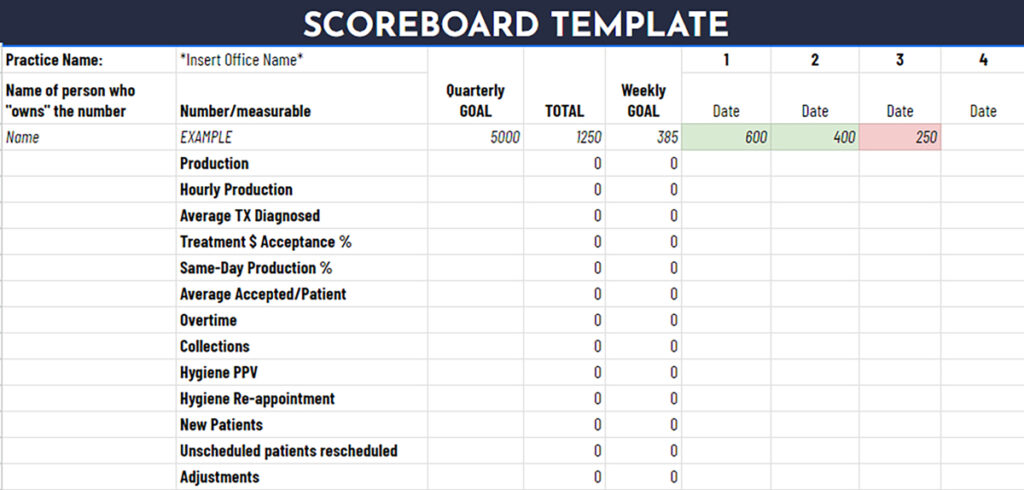How to create a scoreboard to move your business forward.
To increase productivity, DSOs need to keep score. A “scoreboard” is a system of measurement that keeps a dental company on track. It measures individual and company-wide progress through data, numbers, and actionable solutions. Through this system of tracking within a company, wins can be celebrated, and potential red flags identified.
To better understand the use of a scoreboard within the dental organization, imagine you are playing a basketball game. The game of basketball would be difficult if no one was aware of how the team was performing for an entire game. If the team doesn’t know the score, the coach is unable to plan the plays to run or offensive/defensive strategies. This idea is similar to the way a business operates. How can a business keep track of how their employees are performing? Tracking and measuring data is a way to monitor the “score,” hence the law of the scoreboard.
Numbers and metrics can be utilized in the dental industry to improve patient care and retain patients. Every time patient care is delivered, someone is healthier and the company benefits. The more people you treat, the healthier people are.
Measuring workplace data and creating necessary systems to increase employee productivity allows DSOs of all sizes to stand apart from competitors. The following are key pieces of a DSO scoreboard.
Business performance in numbers
When creating a scoreboard, begin by brainstorming a list of actionable items that aim to increase business success. These actions should be measured using numbers. Each position at a company is responsible for their own individual numbers, or key performance indicators (KPIs). It is important to give each individual no more than three KPIs to work toward at a time. This ensures that workplace goals are actionable and achievable. If there are more than three goals at a time, individual employees begin to feel that the goals are unattainable and productivity decreases.
Goals for a business or dental practice can include increasing appointments/scheduling, retaining patients, marketing to new patients, and more. Goals can vary by company. Once a list has been created, reduce it to five to 15 actionable items. Metrics measured should be distinctto each department depending on its individual goals. The way you choose to organize the hierarchy of scoring depends on the goals of the specific department; goals for the marketing department differ from the goals of a dental hygienist.

Reviewed weekly
Review progress toward actionable goals and numbers periodically. Progress checks can be broken into cycles (monthly, quarterly, etc.).
Going back to the basketball analogy, the scoreboard in a game displays the points and allows the team to determine game strategies based on the score so they are more likely to win. In the dental organization, the “score” can be monitored weekly or periodically to gain an understanding of individual and company-wide progress. If the score changes, strategies and workplace tactics can be set in place to course correct and plan better ways to assist patients.
Clear goals: on or off
When the scoreboard is reviewed in a progress check, and a number is off, it is a priority to discuss with employees why this may be the case. Focus on the intention, results, and action of a certain goal. Make sure a strategy is in place to address numbers being off before moving to the analysis of the next goal.
For example, schedule production is a term for how much treatment is scheduled during the week. Weekly meetings should be held to go over if the number of appointments each week meets the projected goal. If weekly numbers were not met, then in a meeting, employees are able to discuss possible strategies to achieve the goal going forward. Following up with patients to schedule appointments, and contacting potential new patients for hygiene appointments, helps to achieve the goal of higher schedule productivity.
Systematically move a number from off to on
There are times when a team struggles to meet performance goals set in place on the scoreboard. It is important to acknowledge that the scoreboard is a measurement of long-term business success. When production is indicated as “off” on the scoreboard, determine five to 10 action items and strategies that a team can work toward to achieve long-term outcomes.
If employees lack a systematic approach to address when a number is off, there is no need to measure the number in the first place. If you aren’t going to manage it, don’t measure it. Be sure all numbers being measured on the scoreboard have actionable goals.
To systematically move a number from being off to back on, first determine what a data point being off means, and how it can be addressed in the workplace. This is called the awareness response process. First, determine what the reaction should be to get the outcome that is needed. Then, turn the reaction into a repeatable process that each team member can understand and follow. When teams are given a strategy to achieve their goals, it becomes an automatic response.
Clear ownership
There is a large amount of coaching, education, training, and support that comes with getting staff to increase their productivity. Actionable solutions will allow staff to take clear ownership of their responsibilities and understand what is expected of them on a monthly, weekly, and daily basis. Data can also exemplify how an employee can change their behavior at work to meet overall business performance goals.
Data has the potential to grow a successful and productive business. Data can provide employees with the tools they need to systematically improve their performance and numbers. Find wins and celebrate those wins with your team. As a positive exercise, have teams circle the top two numbers on the scoreboard and determine what strategies worked to get there.





